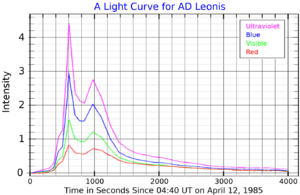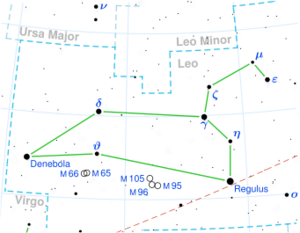Astronomy:AD Leonis
Coordinates: ![]() 10h 19m 36.277s, +19° 52′ 12.06″
10h 19m 36.277s, +19° 52′ 12.06″
| Observation data Equinox J2000.0]] (ICRS) | |
|---|---|
| Constellation | Leo |
| Right ascension | 10h 19m 36.28082s[2] |
| Declination | +19° 52′ 12.0104″[2] |
| Apparent magnitude (V) | 9.32[3] |
| Characteristics | |
| Spectral type | M3.5eV[4] |
| U−B color index | +1.06[3] |
| B−V color index | +1.54[3] |
| Variable type | Flare star[5] |
| Astrometry | |
| Radial velocity (Rv) | +10.67±0.21[2] km/s |
| Proper motion (μ) | RA: –498.620[2] mas/yr Dec.: –43.428[2] mas/yr |
| Parallax (π) | 201.4064 ± 0.0296[2] mas |
| Distance | 16.194 ± 0.002 ly (4.9651 ± 0.0007 pc) |
| Absolute magnitude (MV) | 10.87[6] |
| Details[7] | |
| Mass | 0.423±0.012 M☉ |
| Radius | 0.4233±0.0057 R☉ |
| Luminosity | 0.02359±0.00011 L☉ |
| Surface gravity (log g) | 5.12±0.12 cgs |
| Temperature | 3,477±23 K |
| Metallicity [Fe/H] | −0.19±0.12 dex |
| Rotation | 2.2270+0.0010 −0.0011 d |
| Rotational velocity (v sin i) | 2.4±1.5 km/s |
| Age | 25-300[4] Myr |
| Other designations | |
| Database references | |
| SIMBAD | data |
Location of AD Leonis in the constellation Leo | |
AD Leonis (Gliese 388) is a red dwarf star. It is located relatively near the Sun, at a distance of 16.2 light-years (5.0 parsecs), in the constellation Leo. AD Leonis is a main sequence star with a spectral classification of M3.5V.[4] It is a flare star that undergoes random increases in luminosity.[5][8]
Properties
AD Leonis is an M-type star with a spectral type M3.5eV, indicating it is a main sequence star that displays emission lines in its spectrum. At a trigonometric distance of 16.2 ly (5.0 pc), it has an apparent visual magnitude of 9.43.[6][9] It has about 39–42% of the Sun's mass — above the mass at which a star is fully convective[10] — and 39% of the Sun's radius.[6][11] The projected rotation of this star is only 2.4 km/s, but it completes a rotation once every 2.227 days, indicating a relatively pole-on inclination of about 12.9°.[7] It is a relatively young star with an estimated age of 25–300 million years,[4] and is considered a member of the young disk population.[12]
The variable nature of this star was first observed in 1949 by Katherine C. Gordon and Gerald E. Kron at Lick Observatory.[13] AD Leonis is one of the most active flare stars known, and the emissions from the flares have been detected across the electromagnetic spectrum as high as the X-ray band.[14][15] The net magnetic flux at the surface is about 3 kG.[16] Besides star spots, about 73% of the surface is covered by magnetically active regions.[17] Examination of the corona in X-ray shows compact loop structures that span up to 30% of the size of the star.[18] The average temperature of the corona is around 6.39 MK.[19]
This star is orbiting through the Milky Way galaxy with an eccentricity of 0.028 . This carries the star as close as 8.442 kpc from the galactic core, and as far as 8.926 kpc. The orbital inclination carries it as far as 0.121 kpc from the plane of the galaxy.[20]
In 2021, a superflare on AD Leo was observed simultaneously in X-ray by XMM-Newton and in optical by TESS.[21]
Search for planets
During a 1943 proper motion study by Dirk Reuyl at McCormick Observatory, AD Leonis was suspected of having a companion. However, a 1968 study by Sarah L. Lippincott at Sproul Observatory was unable to confirm this result.[22] A 1997 search with a near-infrared speckle interferometer failed to detect a companion orbiting 1–10 AU from the star.[23] In 2001, an optical coronagraph was used to example the star, but no companion was found.[24] As of 1981, there was no sign of variability in its radial velocity, which would otherwise indicate the presence of an unseen companion.[9]
In 2018, AD Leonis was found to have radial velocity variations with a period of 2.23 days. The star was found to rotate with the same period, suggesting that the stellar rotation may be the cause of the radial velocity signal, but it was thought possible that the signal was caused by a planet of 0.24 |♃|J}}}}}} in a spin-orbit resonance with the star.[25] This was listed as a candidate planet in a 2019 preprint.[26] However, subsequent studies starting in 2020 refuted the planet hypothesis, finding stellar activity to be the most likely explanation for the radial velocity variations.[27][28] A 2022 study confidently ruled out planets more massive than 27 M⊕ orbiting at the stellar rotation period, as well as planets more than 3-6 MJ with periods up to 14 years.[7]
See also
References
- ↑ Hawley, Suzanne L.; Pettersen, Bjorn R. (September 1991). "The Great Flare of 1985 April 12 on AD Leonis". The Astrophysical Journal 378: 725. doi:10.1086/170474. Bibcode: 1991ApJ...378..725H.
- ↑ 2.0 2.1 2.2 2.3 2.4 Vallenari, A. et al. (2022). "Gaia Data Release 3. Summary of the content and survey properties". Astronomy & Astrophysics. doi:10.1051/0004-6361/202243940 Gaia DR3 record for this source at VizieR.
- ↑ 3.0 3.1 3.2 Nicolet, B. (October 1978). "Catalogue of homogeneous data in the UBV photoelectric photometric system". Astronomy and Astrophysics Supplement Series 34: 1–49. Bibcode: 1978A&AS...34....1N.
- ↑ 4.0 4.1 4.2 4.3 Shkolnik, Evgenya; Liu, Michael C.; Reid, I. Neill (July 2009). "Identifying the young low-mass stars within 25 pc. I. Spectroscopic observations". The Astrophysical Journal 699 (1): 649–666. doi:10.1088/0004-637X/699/1/649. Bibcode: 2009ApJ...699..649S.
- ↑ 5.0 5.1 Kukarkin, B. V.; Kholopov, P. N.; Pskovsky, Y. P.; Efremov, Y. N.; Kukarkina, N. P.; Kurochkin, N. E.; Medvedeva, G. I. (1971). "The third edition, containing information on 20,437 variable stars discovered and designated till 1968". General Catalogue of Variable Stars (3rd ed.). Bibcode: 1971GCVS3.C......0K.
- ↑ 6.0 6.1 6.2 "The One Hundred Nearest Star Systems". Georgia State University. 1 January 2009. http://www.astro.gsu.edu/RECONS/TOP100.posted.htm.
- ↑ 7.0 7.1 7.2 Kossakowski, D. et al. (October 2022). "The CARMENES search for exoplanets around M dwarfs. Stable radial-velocity variations at the rotation period of AD Leonis: A test case study of current limitations to treating stellar activity". Astronomy & Astrophysics 666: A143. doi:10.1051/0004-6361/202243773. Bibcode: 2022A&A...666A.143K.
- ↑ 8.0 8.1 "V* AD Leo – Flare Star". Centre de Données astronomiques de Strasbourg. http://simbad.u-strasbg.fr/simbad/sim-basic?Ident=GJ+388.
- ↑ 9.0 9.1 Pettersen, B. R.; Coleman, L. A. (December 1981). "Chromospheric lines in red dwarf flare stars, I - AD Leonis and GX Andromedae". Astrophysical Journal 251 (12): 571–82. doi:10.1086/159500. Bibcode: 1981ApJ...251..571P.
- ↑ Reiners, Ansgar; Basri, Gibor (March 2009). "On the magnetic topology of partially and fully convective stars". Astronomy and Astrophysics 496 (3): 787–790. doi:10.1051/0004-6361:200811450. Bibcode: 2009A&A...496..787R.
- ↑ Reiners, Ansgar; Basri, Gibor; Browning, Matthew (February 2009). "Evidence for magnetic flux saturation in rapidly rotating M stars". The Astrophysical Journal 692 (1): 538–545. doi:10.1088/0004-637X/692/1/538. Bibcode: 2009ApJ...692..538R. https://ore.exeter.ac.uk/repository/bitstream/handle/10871/10302/Evidence%20for%20Magnetic%20Flux%20Saturation%20in%20Rapidly%20Rotating%20M%20Stars.pdf.
- ↑ Sciortino, S.; Maggio, A.; Favata, F.; Orlando, S. (February 1999). "X-ray spectroscopy of the active dM stars: AD Leo and EV Lac". Astronomy & Astrophysics 342 (2): 502–14. Bibcode: 1999A&A...342..502S.
- ↑ Gordon, Katherine C.; Kron, Gerald E. (October 1949). "Flare of a dMe star, BD+20°2465, observed photoelectrically". Publications of the Astronomical Society of the Pacific 61 (362): 210–214. doi:10.1086/126179. Bibcode: 1949PASP...61..210G.
- ↑ Osten, Rachel A.; Bastian, T. S. (February 2008). "Ultra-high time resolution observations of radio bursts on AD Leonis". The Astrophysical Journal 674 (2): 1078–1085. doi:10.1086/525013. Bibcode: 2008ApJ...674.1078O.
- ↑ Schmitt, Jürgen H. M. M.; Fleming, T. A.; Giampapa, M. S. (September 1995). "The X-ray view of the low-mass stars in the solar neighborhood". Astrophysical Journal 450 (9): 392–400. doi:10.1086/176149. Bibcode: 1995ApJ...450..392S.
- ↑ Reiners, Ansgar (May 2007). "The narrowest M dwarf line profiles and the rotation-activity connection at very slow rotation". Astronomy and Astrophysics 467 (1): 259–268. doi:10.1051/0004-6361:20066991. Bibcode: 2007A&A...467..259R.
- ↑ Crespo-Chacón, I.; Montes, D.; García-Alvarez, D.; Fernández-Figueroa, M. J.; López-Santiago, J.; Foing, B. H. (June 2006). "Analysis and modeling of high temporal resolution spectroscopic observations of flares on AD Leonis". Astronomy and Astrophysics 452 (3): 987–1000. doi:10.1051/0004-6361:20053615. Bibcode: 2006A&A...452..987C.
- ↑ Christian, D. J.; Mathioudakis, M.; Bloomfield, D. S.; Dupuis, J.; Keenan, F. P.; Pollacco, D. L.; Malina, R. F. (August 2006). "Opacity in the upper atmospheres of active stars. II. AD Leonis". Astronomy and Astrophysics 454 (3): 889–894. doi:10.1051/0004-6361:20054404. Bibcode: 2006A&A...454..889C. http://scholarworks.csun.edu/bitstream/10211.3/172062/1/christian-etal-opacity-2006.pdf.
- ↑ Johnstone, C. P.; Güdel, M. (June 2015). "The coronal temperatures of low-mass main-sequence stars". Astronomy & Astrophysics 578: 4. doi:10.1051/0004-6361/201425283. A129. Bibcode: 2015A&A...578A.129J.
- ↑ "The galactic orbits of nearby UV Ceti stars". Revista Mexicana de Astronomía y Astrofísica 34: 37–46. April 1998. Bibcode: 1998RMxAA..34...37A.
- ↑ Stelzer, B.; Caramazza, M.; Raetz, St.; Argiroffi, C.; Coffaro, M. (2022). "The Great Flare of 2021 November 19 on AD Leo. Simultaneous XMM-Newton and TESS observations". Solar and Stellar Astrophysics 667. doi:10.1051/0004-6361/202244642. Bibcode: 2022A&A...667L...9S.
- ↑ Lippincott, S. L. (March 1969). "Astrometric study of BD+20 2465 from photographs taken with the Sproul 24 inch refractor". Astronomical Journal 74: 224–228. doi:10.1086/110795. Bibcode: 1969AJ.....74..224L.
- ↑ Leinert, C.; Henry, T.; Glindemann, A.; McCarthy, D. W. Jr. (September 1997). "A search for companions to nearby southern M dwarfs with near-infrared speckle interferometry". Astronomy and Astrophysics 325: 159–166. Bibcode: 1997A&A...325..159L.
- ↑ Oppenheimer, B. R.; Golimowski, D. A.; Kulkarni, S. R.; Matthews, K.; Nakajima, T.; Creech-Eakman, M.; Durrance, S.T. (April 2001). "A coronagraphic survey for companions of stars within 8 parsecs". The Astronomical Journal 121 (4): 2189–2211. doi:10.1086/319941. Bibcode: 2001AJ....121.2189O.
- ↑ Tuomi, Mikko et al. (May 2018). "AD Leonis: Radial Velocity Signal of Stellar Rotation or Spin-Orbit Resonance?". The Astronomical Journal 155 (5): 192. doi:10.3847/1538-3881/aab09c. Bibcode: 2018AJ....155..192T.
- ↑ Tuomi, M.; Jones, H. R. A.; Butler, R. P.; Arriagada, P.; Vogt, S. S.; Burt, J.; et al. (2019-06-11). "Frequency of planets orbiting M dwarfs in the Solar neighbourhood". arXiv:1906.04644 [astro-ph.EP].
- ↑ Carleo, I.; Malavolta, L.; Lanza, A. F.; Damasso, M.; Desidera, S.; Borsa, F. et al. (2020). "The GAPS Programme at TNG XXI – A GIARPS case-study of known young planetary candidates: Confirmation of HD 285507 b and refutation of AD Leo b". Astronomy & Astrophysics A5: 638. doi:10.1051/0004-6361/201937369. Bibcode: 2020A&A...638A...5C.
- ↑ Carmona, A. et al. (May 2023). "Near-IR and optical radial velocities of the active M dwarf star Gl 388 (AD Leo) with SPIRou at CFHT and SOPHIE at OHP: A 2.23 day rotation period and no evidence for a corotating planet". Astronomy & Astrophysics. doi:10.1051/0004-6361/202245660.
External links
- Segura, Antígona; Walkowicz, Lucianne M.; Meadows, Victoria; Kasting, James; Hawley, Suzanne (2010). "The effect of a strong stellar flare on the atmospheric chemistry of an Earth-like planet orbiting an M dwarf". Astrobiology 10 (7): 751–771. doi:10.1089/ast.2009.0376. PMID 20879863. Bibcode: 2010AsBio..10..751S.
 |



